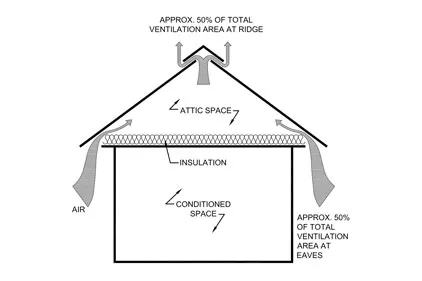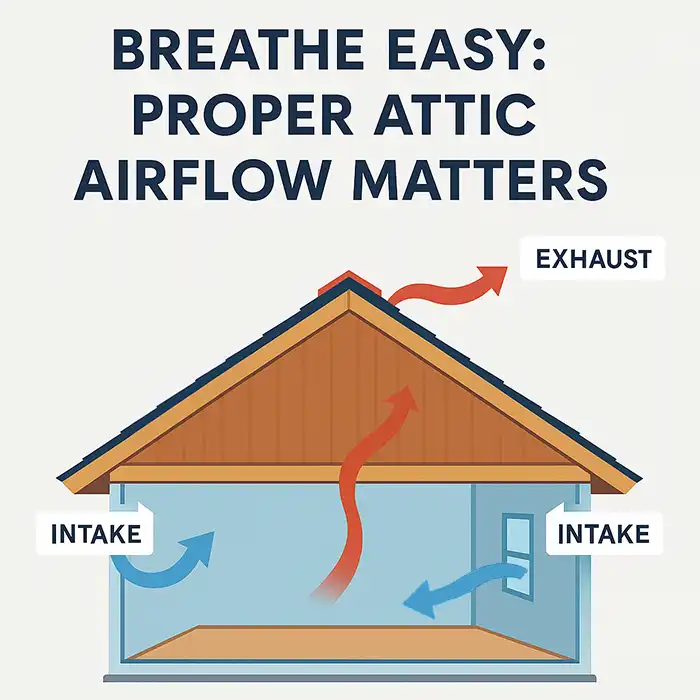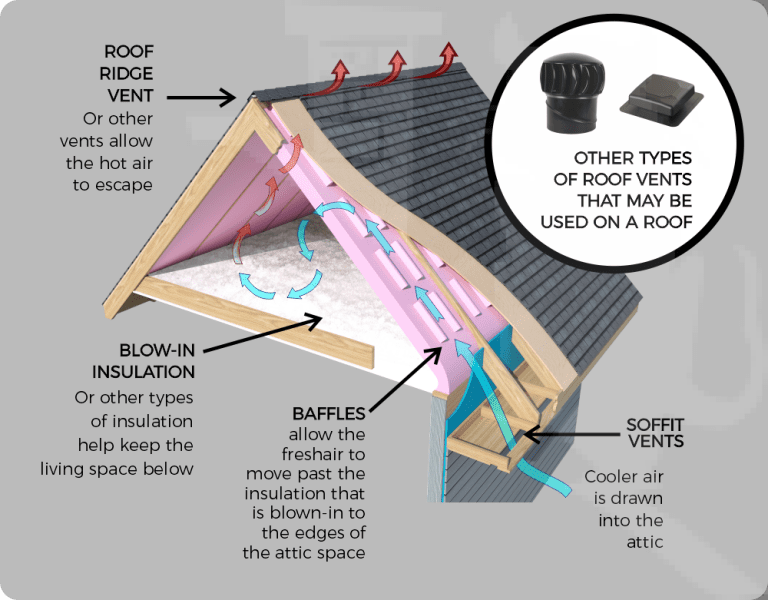Is your attic feeling stuffy or unusually warm? Proper ventilation could be the simple fix you need.
If you’ve ever wondered how to keep your attic fresh and prevent costly damage, you’re in the right place. You’ll discover clear, easy steps to ventilate your attic the right way. By the end, you’ll know exactly what to do to protect your home, improve energy efficiency, and maintain a healthier living space.
Ready to learn how to breathe new life into your attic? Let’s get started.
Benefits Of Attic Ventilation
Proper attic ventilation offers many important benefits. It helps keep your home comfortable and protects your roof and attic space. Good airflow in the attic lowers heat buildup and controls moisture. These effects improve your home’s overall health and performance.
Improved Energy Efficiency
Ventilated attics reduce heat buildup in summer. This lowers cooling costs by easing the load on air conditioners. In winter, proper ventilation prevents ice dams that damage roofs. Balanced attic temperature helps your heating and cooling systems work better. This saves energy and reduces utility bills.
Moisture Control
Moisture from daily activities can get trapped in an unventilated attic. This causes mold, mildew, and wood rot. Ventilation removes excess moisture and allows fresh air circulation. Dry attic spaces protect insulation and structural components. This reduces health risks and costly repairs.
Extended Roof Lifespan
Heat and moisture damage roofing materials over time. Ventilation keeps the attic cool and dry, preventing this damage. This reduces warping, cracking, and premature aging of shingles and wood. A well-ventilated attic helps your roof last longer and stay strong.

Credit: www.roofingcontractor.com
Types Of Attic Ventilation
Proper attic ventilation is key to maintaining a healthy home environment. Different types of vents serve unique roles in ensuring air flows correctly through your attic space. Understanding these options helps you choose the best combination for your home’s needs and climate.
Ridge Vents
Ridge vents run along the peak of your roof, allowing hot air to escape naturally. They create a continuous outlet that works best with intake vents like soffit vents. If you’ve ever felt hot air trapped in your attic, ridge vents can provide a steady escape route for that heat.
Soffit Vents
Soffit vents sit under the eaves of your roof and act as intake points for cool air. This air then moves upward, pushing hot air out through ridge or gable vents. Without soffit vents, your attic won’t get enough fresh air, which can trap moisture and heat.
Gable Vents
Gable vents are installed on the triangular walls at each end of your attic. They provide both intake and exhaust ventilation depending on wind direction. If your attic has limited roof space, gable vents offer a simple way to improve airflow without major roof modifications.
Turbine Vents
Turbine vents use wind power to spin and pull hot air out of your attic. They are effective in windy areas and can work alongside other vent types to boost ventilation. Have you noticed how a spinning turbine vent can instantly draw out heat on a breezy day? That’s the power of active ventilation without electricity.
Calculating Ventilation Needs
Calculating the ventilation needs of your attic is essential for proper airflow. It helps keep the space dry and prevents heat buildup. Without correct ventilation, moisture can cause mold and damage. Understanding your attic’s size and ventilation rules ensures balanced air movement. This section guides you through measuring attic space, ventilation ratio guidelines, and balancing intake and exhaust.
Measuring Attic Space
Start by measuring your attic’s length and width. Multiply these numbers to get the total square footage. If your attic has multiple sections, measure each area separately. Add all sections for the total attic space. Accurate measurements help determine how much ventilation your attic needs.
Ventilation Ratio Guidelines
Ventilation needs depend on the attic’s size. The common rule is 1 square foot of ventilation for every 150 square feet of attic floor space. This means if your attic is 1,500 square feet, you need 10 square feet of ventilation. This includes both intake and exhaust vents. Follow this ratio to avoid too little or too much airflow.
Balancing Intake And Exhaust
Proper ventilation requires both intake and exhaust vents. Intake vents let fresh air enter the attic. Exhaust vents allow hot, moist air to leave. Keep intake and exhaust balanced for steady airflow. A good balance prevents moisture buildup and heat damage. Use soffit vents for intake and ridge or gable vents for exhaust. Check vent sizes to match the calculated ventilation needs.
Installing Intake Vents
Installing intake vents ensures proper attic ventilation. These vents allow fresh air to flow in, reducing heat and moisture buildup. Proper placement helps maintain a balanced airflow, prolonging roof life and improving energy efficiency.
Installing intake vents in your attic is crucial for proper ventilation. They allow fresh air to enter, ensuring temperature control and moisture prevention. A well-ventilated attic extends roof life and enhances energy efficiency. Let’s explore how to install intake vents effectively.Choosing Soffit Vents
Selecting the right soffit vents is essential. They come in various materials like aluminum, vinyl, or wood. Choose a material that matches your home’s exterior. Ensure the vents are durable and weather-resistant. Proper sizing of vents is important for optimal airflow.Placement Tips
Place soffit vents evenly along the eaves of the house. This ensures consistent airflow throughout the attic. Maintain a balance with exhaust vents on the roof. Keep vents away from obstacles like beams or pipes. Spacing is crucial for effective air circulation.Avoiding Blockages
Ensure soffit vents remain unobstructed for maximum airflow. Avoid covering vents with insulation or debris. Regularly inspect and clean vents to prevent blockages. Consider installing vent screens to keep out pests and debris. This will ensure continuous air movement.Setting Up Exhaust Vents
Setting up exhaust vents is a key part of keeping your attic well-ventilated. Exhaust vents allow hot, moist air to escape, which prevents damage and keeps your home comfortable. Knowing how to place and use these vents effectively can make a big difference in your attic’s airflow.
Positioning Ridge Vents
Ridge vents run along the peak of your roof, making them an excellent choice for exhausting hot air. You want to place these vents at the very top of the roof where warm air naturally rises. This setup creates a continuous flow, pushing hot air out evenly across the entire attic.
Make sure the ridge vent is installed with enough clearance beneath the roofing material to allow air to escape freely. If you’ve ever noticed a buildup of heat in your attic during summer, adjusting or adding ridge vents might be the fix you need.
Using Gable Or Turbine Vents
Gable vents are located on the walls at the ends of the attic. They provide good airflow if you don’t have a ridge vent or want extra ventilation. These vents work best when paired with soffit vents to pull cool air in and push hot air out.
Turbine vents spin with the wind, actively pulling hot air out of the attic. They can be very effective but depend on wind conditions to work well. If your area is usually calm, you might want to consider combining turbine vents with other exhaust options.
Ensuring Proper Airflow
Proper airflow requires a balance between intake and exhaust vents. Intake vents, typically placed in the soffits, bring cool air in while exhaust vents let hot air out. Without this balance, your attic won’t ventilate efficiently, no matter how many vents you install.
Ask yourself: Are there enough intake vents to match your exhaust vents? If not, you could be creating negative pressure, pulling moisture into your attic instead of pushing it out. To avoid this, calculate the net free area (NFA) of your vents, ensuring intake and exhaust areas are roughly equal.

Credit: www.firststarexteriors.com
Maintaining Attic Ventilation
Maintaining attic ventilation is essential to keep your home comfortable and to protect the structure from moisture and heat damage. Proper upkeep helps your ventilation system work efficiently year-round. Neglecting this can lead to costly repairs and reduce your attic’s lifespan.
Regular Inspection
You should check your attic ventilation at least twice a year, ideally in spring and fall. Look for signs of poor airflow like moisture buildup or unusual odors. Inspect vents to ensure they are not blocked or damaged.
Have you noticed any hotspots or mold in your attic? These could indicate ventilation problems that need immediate attention.
Clearing Debris
Leaves, dust, and nests can block vents and restrict airflow. Make it a habit to clear away debris regularly to keep the air moving freely. Use a soft brush or a vacuum to clean the vent covers gently.
Don’t forget to check the soffit vents around your roofline. These are often overlooked but critical for proper intake ventilation.
Checking For Damage
Inspect your vents for cracks, rust, or loose fittings. Damaged vents can let moisture in or allow heat to escape, defeating the purpose of ventilation. Replace or repair any faulty components promptly to maintain efficiency.
Think about the last time you replaced a vent—could a small fix now prevent major problems later?
Common Ventilation Mistakes
Getting attic ventilation right is more than just adding vents and hoping for the best. Many homeowners make mistakes that can actually harm their attic’s health and your home’s energy efficiency. Understanding common ventilation errors helps you avoid costly repairs and keeps your attic in peak condition.
Overventilation Risks
You might think more vents equal better airflow, but too much ventilation can backfire. Overventilation can cause your attic to lose heat quickly in winter, raising your heating bills. It can also draw in moisture from outside, increasing the risk of mold growth.
Ask yourself: Are you balancing intake and exhaust vents properly? An imbalance may create negative pressure, pulling conditioned air from your living space into the attic. This not only wastes energy but also reduces indoor comfort.
Blocked Vents
Blocked vents are a silent threat. Debris, insulation, or even nests can clog your vents without you noticing. When vents are blocked, airflow slows or stops, trapping heat and moisture inside your attic.
Regularly inspect your vents to ensure they’re clear. Simple checks can prevent major problems like wood rot or ice dams. Have you checked your attic vents this season?
Ignoring Moisture Issues
Ventilation isn’t just about airflow; it’s about moisture control too. Moisture from showers, cooking, and laundry can rise into the attic and condense on cold surfaces. If your attic lacks proper ventilation, this moisture builds up, causing mold and structural damage.
Consider installing vapor barriers and ensuring vents allow moisture to escape. Ignoring this can lead to costly repairs down the road. How confident are you that your attic stays dry year-round?

Credit: www.northeast-home.com
Frequently Asked Questions
What Are The Benefits Of Attic Ventilation?
Proper attic ventilation reduces heat buildup and moisture. It prevents mold growth, lowers cooling costs, and extends roof lifespan. Good airflow keeps your home comfortable and energy-efficient year-round.
How Do I Know If My Attic Is Ventilated Properly?
Look for signs like uneven temperatures, musty odors, or moisture buildup. Check for balanced intake and exhaust vents. Proper ventilation maintains consistent airflow and prevents heat or moisture problems.
What Types Of Vents Are Best For Attic Ventilation?
Common vents include soffit, ridge, gable, and turbine vents. Combining intake vents (like soffits) with exhaust vents (like ridge vents) ensures optimal airflow. Choose vents based on your roof design and climate.
Can Attic Ventilation Prevent Ice Dams In Winter?
Yes, proper ventilation keeps attic temperatures close to outside air. This prevents snow on the roof from melting and refreezing at the edges, reducing ice dams and roof damage.
Conclusion
Proper attic ventilation keeps your home safe and comfortable. It helps stop moisture and heat build-up. This protects your roof and lowers energy bills. Use vents like ridge, soffit, and gable for best airflow. Check your attic regularly to ensure good ventilation.
Small steps make a big difference in home care. Start today for a cooler, drier attic tomorrow.





